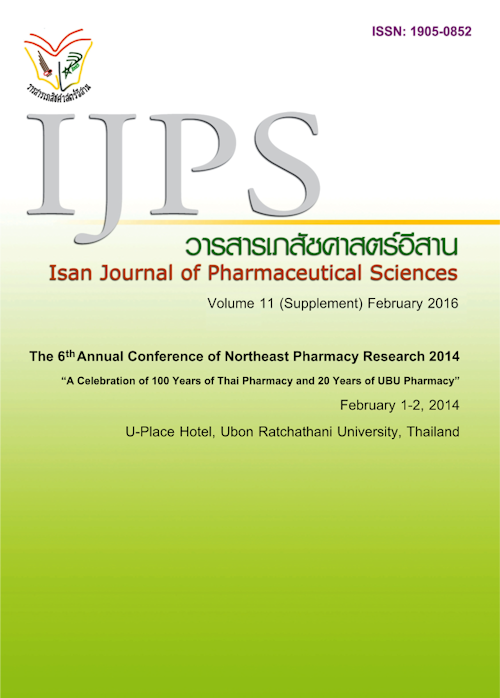Conservation and Development of Traditional Thai lip Care Products for Business Extension
Main Article Content
Abstract
Introduction: Traditional Thai lip care product has been used to prevent dry lip since ancient times. Nowadays the younger generation barely knows what the product is, because there are many modern cosmetic lip care products in the market. Improving the product’s figures by making them more beautiful and pleasant is very important to attract consumers. Thus this study aimed to develop Traditional Thai lip care product by adding the plant extracts to make them look colorful and more modern, in order to satisfy and persuade new generation consumers to use the products. Materials and Method: The natural beeswax was selected as the main component of traditional lip balms. Eleven lip formulations were prepared, namely lip balm base, lip balm containing menthol, lip balm containing orange oil flavor and lip balm containing natural extracts (which are derived from Tumeric rhizome, Yellow Cotton flower, Passion fruit, Roselle petal, Sacred lotus leaf, Swamp algae, Annatto seed and Mao Luang fruit). The best formulations were chosen based on a 9-point hedonic scale evaluated by 10 consumers. Lip hydration levels, when applying the best lip balm, were further examined in 30 Thai volunteers. Results: There were five out of the eleven formulations gaining highest 9-point hedonic scores: lip balm containing Annatto seed extract (8.10±0.99), Mao Luang extract (8.00±1.25), orange oil flavor (7.50±1.43), menthol (6.60±1.43) and lip balm base (6.30±0.95) and the results of lip hydrate level showed that the application of the modified traditional Thai lip balm base and lip balm containing Mao Luang extract could maintain lip hydration from 5 minutes to 180 minutes after application in comparison to untreated lip. Conclusion: Therefore, modified traditional Thai balms may be promising products for increased the lip hydration. In addition, lip gloss and lipstick balm-derived natural beeswax could be prepared to obtain a variety of those lip care products.
Article Details
In the case that some parts are used by others The author must Confirm that obtaining permission to use some of the original authors. And must attach evidence That the permission has been included
References
Avinash MD, Hari AM, Pradeep NS. Herbal lipstick formulation: a new approach. International Journal of Research in Ayurveda & Pharmacy. 2(6) (2011) 1795-1797.
Barrozo MAS, Santos KG, Cunha FG. Mechanical extraction of natural dye extract from Bixa orellana seeds in spouted bed. Industrial Crops and Products. 45 (2013) 279-282.
Djilani A, Legseir B, Soulimani R, Dickob A, Yaunos C. New extraction technique for alkaloids. Journal of Brazilian Chemistry Society. 17 (2006) 518-520.
Kameda T, Tamada Y. Variable-temperature 13C solid-state NMR study of the molecular structure of honeybee wax and silk. International Journal of Biological Macromolecules. 44(1) (2009) 64-69.
Kim SDHL, Park S-Y, Yong J-Y, Curcuminoids from Curcuma longa L. (Zingiberaceae) that protect PC12 rat pheochromocytoma and normal human umbilical vein endothelial cells from βA (1-42) insult. Neuroscience Letter. 303 (2001) 57-61.
Kobayshi H, Tagami H. Functional properties of the surface of the vermilion border of the lips are distinct from those of the facial skin. Br J Dermatol. 150 (2004) 563-567.
Lim J, Wood A, Green BG. Derivation and evaluation of a labeled hedonic scale. Chemical Sences. 34 (2009) 739-751.
Luo W, Li T, Wang C, Huang F. Discovery of beeswax as binding agent on a 6th-century BC Chinese Turquoise-inlaid Bronzesword. Journal of Archaeological Science. 39(5) (2012) 1227-1237.
Mortensen A. Carotenoids and other pigments as natural colorants. Pure Apply Chemistry. 78(80) (2006) 1477-1491.
Nicolas L, Marquilly C, O’Mahony M. The 9-point hedonic scale: are words and numbers compatible. Food Quality and Preference. 21(8) (2010) 1008-1015.
Paul R, Salans C, Erra P. Colloids and Surfaces A: Physichemical and Engineering Aspects. Study of a natural dye solubilisation in o/w microemulsions and its dyeing behavior. 253 (1-3) (2005) 175-181.
Rajin M, Bono A, Mun HC. Optimisation of natural ingredient based lipstick formulation by using mixture design. Journal of Applied Sciences. 7(15) (2007) 2099-2103.
Rosas-Nexticapa M, Angulo O, O’Mahony M. How well doses the 9-point hedonic scale predictpurchase frequency? Journal of Sensory studies. 20 (2005) 313-331.
Rouhani S, Alizadeh N, Salimi S, Haji-Ghasemi T. Progress in Color, Colorants and Coatings. Ultrasonic assisted extraction of natural pigments from rhizomes of Curcuma longa L. 2 (2009) 103-113.
Sachindra NM, Mahendrakar NS. Process optimization for extraction of carotenoids from shrimp waste with vegetable oils. Bioresource Technology. 96 (2005) 1195-1200.
Srimal RC. Turmeric: a brief review of its medicinal properties. Fitoterapia. 68 (1997) 483-493.
Shotipruk A, Kaufman PB, Wang HY. Feasibility study of repeated harvesting of menthol biological viable Menth X Piperrata using ultrasonic extraction. Biotechnology Progress. 17 (2001) 924-928.
Trookman NS, Rizer RL, Ford R, Mehta R, Gotz, V. Clinical assessment of a combination lip treatment to restore moisturizatin and fullness. The Journal of Clinical and Aesthetic Dermatology. 2(12) (2009) 44-48.
Ya-Xian Z, Suetake T, Tagami H. Number of cell layers of the stratum corneum in normal skin – relationship to the anatomical location on the body, age, sex and physical parameters. Arch Dermatol Res. 291 (1999) 563-567


